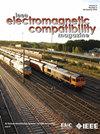关于为评估测试实验室能力声明而对电磁兼容性能力测试定量数据进行建模和分析的正确方法
IF 2
3区 计算机科学
Q3 ENGINEERING, ELECTRICAL & ELECTRONIC
IEEE Transactions on Electromagnetic Compatibility
Pub Date : 2024-11-20
DOI:10.1109/TEMC.2024.3467039
引用次数: 0
摘要
用于分析定量电磁兼容性(EMC)能力测试(PT)数据的传统统计程序过于简单,因为它们隐含地基于以下错误假设:首先,给定一轮的PT数据构成了从正态分布的潜在总体中抽取的随机样本,因此,正态性标准可用于基于任意预定义的z值选择为PT参与者设置合格/不合格阈值;其次,最大允许误差值不重要,可以忽略。这两个基本错误会导致PT合格/不合格结果的错误分类,这可能会对EMC测试实验室及其客户造成严重的经济后果。本文首先从评估所使用的统计方法以及如何应用合格/不合格标准的角度回顾了有关定量EMC PT的已发表文献。接下来,本文将讨论这些统计过程错误的影响。最后,详细介绍了一种实用的、更精确的替代贝叶斯方法,该方法将最大允许误差作为其分析模型中的先验信息。该方法将定量EMC PT数据视为没有特定假定分布的总体。本文章由计算机程序翻译,如有差异,请以英文原文为准。
On the Correct Approach to the Modeling and Analysis of Quantitative EMC Proficiency Testing Data for the Purpose of Evaluating Test Laboratory Claims of Competency
Traditional statistical procedures used for analyzing quantitative electromagnetic compatibility (EMC) proficiency test (PT) data are overly simplistic, given that they are implicitly based upon the following erroneous assumptions: first, PT data in a given round constitute a random sample drawn from an underlying population that is distributed normally, and therefore, the normality criteria can used to set the pass/fail threshold for PT participants based upon an arbitrary, predefined choice of
Z
-value; and second the maximum permissible error values are unimportant and can be ignored. Those two fundamental errors produce misclassified PT pass/fail results, which can have serious economic consequences for both EMC test laboratories and their customers. This article first reviews the published literature on quantitative EMC PT from the standpoint of assessing the statistical methodologies used and how the pass/fail criteria were applied. Next, this article discusses the effects of these statistical procedure errors. Finally, it details a practical, more accurate alternative Bayesian method that incorporates the maximum permissible error as the
a priori
information in its analysis model. This method treats the quantitative EMC PT data as a population with no specific presumed distribution.
求助全文
通过发布文献求助,成功后即可免费获取论文全文。
去求助
来源期刊
CiteScore
4.80
自引率
19.00%
发文量
235
审稿时长
2.3 months
期刊介绍:
IEEE Transactions on Electromagnetic Compatibility publishes original and significant contributions related to all disciplines of electromagnetic compatibility (EMC) and relevant methods to predict, assess and prevent electromagnetic interference (EMI) and increase device/product immunity. The scope of the publication includes, but is not limited to Electromagnetic Environments; Interference Control; EMC and EMI Modeling; High Power Electromagnetics; EMC Standards, Methods of EMC Measurements; Computational Electromagnetics and Signal and Power Integrity, as applied or directly related to Electromagnetic Compatibility problems; Transmission Lines; Electrostatic Discharge and Lightning Effects; EMC in Wireless and Optical Technologies; EMC in Printed Circuit Board and System Design.

 求助内容:
求助内容: 应助结果提醒方式:
应助结果提醒方式:


